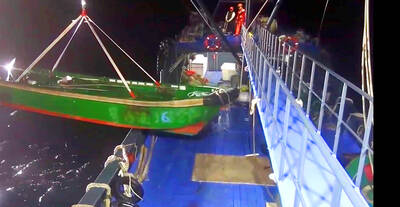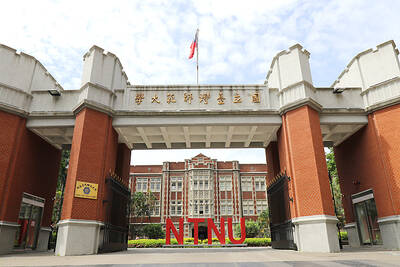It sounds like an assignment from a creative writing class -- make up a story about how the captain and crew vanished from a boat found drifting on the high seas.
It's not. It's a real-life riddle that Australian investigators are trying to solve by piecing together the movements of the High Aim 6 between Oct. 31, when it left the port of Liuchiu, and Jan. 8, when it was boarded by navy personnel 250km off the west coast of Broome in Western Australia.
The first guess was that the Taiwanese-owned, Indonesian-flagged fishing boat ran out of fuel, leaving those on board with the option of drifting out into the Indian Ocean or taking to the lifeboats and seeking a safe shore on Australia's west coast.
But that theory is easily dismissed. There was plenty of fuel, as well as food and water, on the modern long-line fishing boat -- and there is no evidence that lifeboats were launched.
Another possibility is that the 20m vessel was boarded by pirates sometime late in December after the owners, Tsai Huang Shueh-er, spoke by radio telephone to the captain.
This also seems unlikely. There was no sign of a struggle and the hijackers almost certainly would have made off with the boat.
Personal belongings were found on the 130-tonne vessel. There were seven toothbrushes -- indicating that as well as the Taiwanese captain and first mate there were at least five Indonesian crew.
The initial suspicions were that the High Aim 6 was carrying illegal migrants intending to claim asylum when they reached Australia.
But in the hold was a catch of rotting fish, evidence that the ship was a legitimate fishing vessel.
Australian investigators freely admit that they are stumped.
Geoff Rohan, of the Australian Fisheries Management Authority, is even considering the possibility that the High Aim 6 may have drifted without a crew from the US' Marshall Islands, its last known location.
A search of 24,000km2 around where the boat was intercepted has failed to find any trace of the captain and crew.
Police spokesman Bill Graham said that "as time goes on, the prospects of locating the crew alive decrease."
Among the oddities is that when the High Aim 6 was first sighted, the motor was running and the propeller was turning. The ship was underway.
But when it was boarded five days later, the engine was dead. The rudder lock was on, forcing the ship to drift in one direction rather than float around in circles.
A line of enquiry is that the boat was in the vicinity of South Pacific cyclones at the start of the month. The gale-force winds could have sparked an emergency that forced the crew to leave their ship.
But that, too, is a long shot.
Lee Ah-duey, director of the Liu Chiou District Fishing Association in southern Taiwan said that the best clue into their fate is a record of calls made on Bali with a mobile phone belonging to the chief engineer, Lin Chung-lee (林中立).
Phone records show that 87 local calls were made on Bali with the phone, said Lee, who had no other details.
The crew's disappearance in calm waters is reminiscent of the ill-fated Marie Celeste, found drifting in the Atlantic in 1872.
That mystery wasn't solved.

Taiwan yesterday condemned the recent increase in Chinese coast guard-escorted fishing vessels operating illegally in waters around the Pratas Islands (Dongsha Islands, 東沙群島) in the South China Sea. Unusually large groupings of Chinese fishing vessels began to appear around the islands on Feb. 15, when at least six motherships and 29 smaller boats were sighted, the Coast Guard Administration (CGA) said in a news release. While CGA vessels were dispatched to expel the Chinese boats, Chinese coast guard ships trespassed into Taiwan’s restricted waters and unsuccessfully attempted to interfere, the CGA said. Due to the provocation, the CGA initiated an operation to increase

CHANGING LANDSCAPE: Many of the part-time programs for educators were no longer needed, as many teachers obtain a graduate degree before joining the workforce, experts said Taiwanese universities this year canceled 86 programs, Ministry of Education data showed, with educators attributing the closures to the nation’s low birthrate as well as shifting trends. Fifty-three of the shuttered programs were part-time postgraduate degree programs, about 62 percent of the total, the most in the past five years, the data showed. National Taiwan Normal University (NTNU) discontinued the most part-time master’s programs, at 16: chemistry, life science, earth science, physics, fine arts, music, special education, health promotion and health education, educational psychology and counseling, education, design, Chinese as a second language, library and information sciences, mechatronics engineering, history, physical education

The Chinese military has boosted its capability to fight at a high tempo using the element of surprise and new technology, the Ministry of National Defense said in the Quadrennial Defense Review (QDR) published on Monday last week. The ministry highlighted Chinese People’s Liberation Army (PLA) developments showing significant changes in Beijing’s strategy for war on Taiwan. The PLA has made significant headway in building capabilities for all-weather, multi-domain intelligence, surveillance, operational control and a joint air-sea blockade against Taiwan’s lines of communication, it said. The PLA has also improved its capabilities in direct amphibious assault operations aimed at seizing strategically important beaches,

‘MALIGN PURPOSE’: Governments around the world conduct espionage operations, but China’s is different, as its ultimate goal is annexation, a think tank head said Taiwan is facing a growing existential threat from its own people spying for China, experts said, as the government seeks to toughen measures to stop Beijing’s infiltration efforts and deter Taiwanese turncoats. While Beijing and Taipei have been spying on each other for years, experts said that espionage posed a bigger threat to Taiwan due to the risk of a Chinese attack. Taiwan’s intelligence agency said China used “diverse channels and tactics” to infiltrate the nation’s military, government agencies and pro-China organizations. The main targets were retired and active members of the military, persuaded by money, blackmail or pro-China ideology to steal